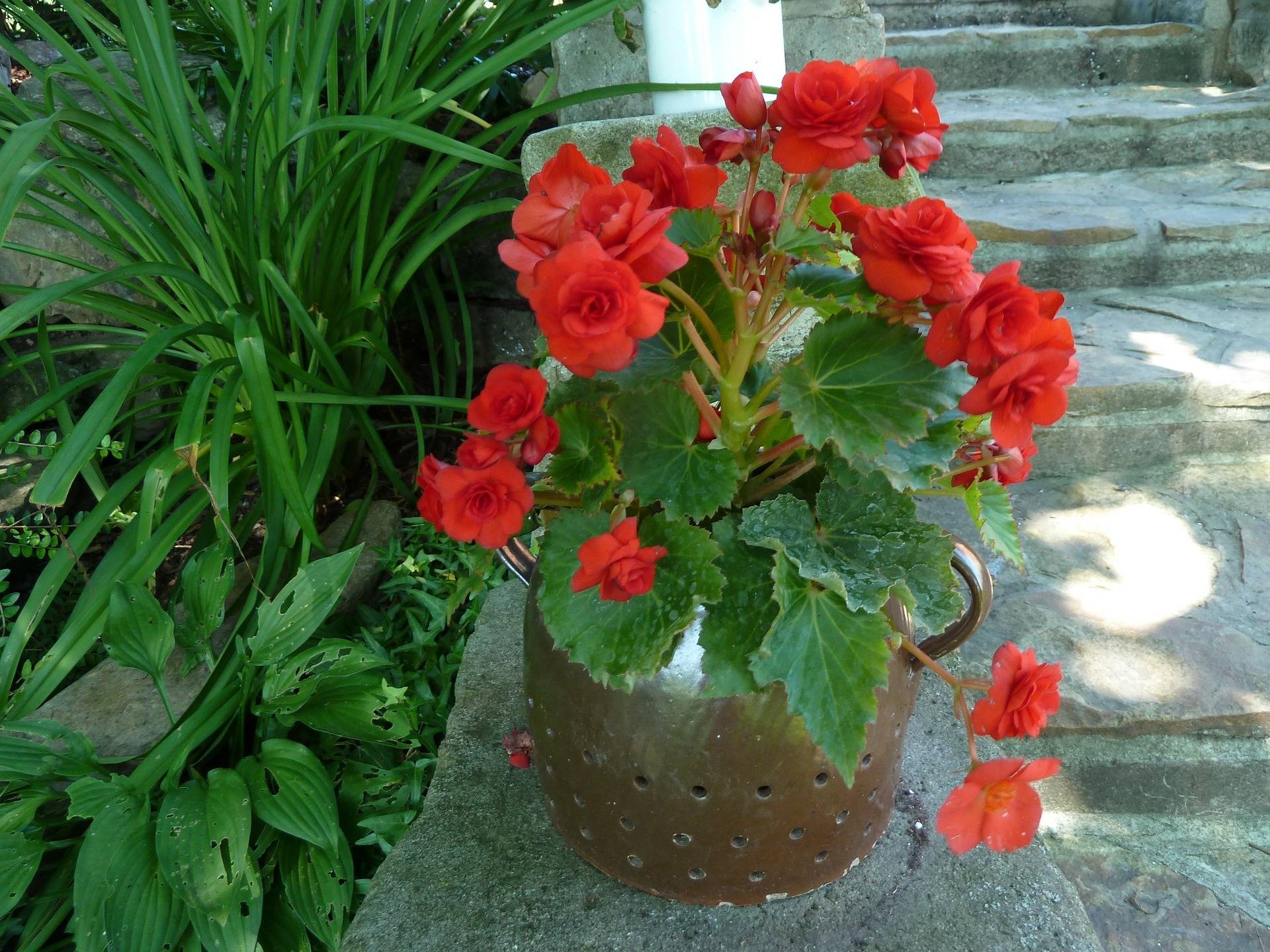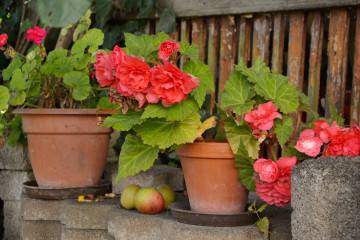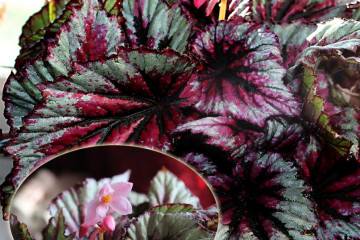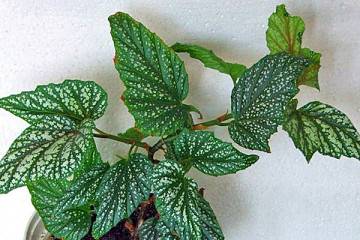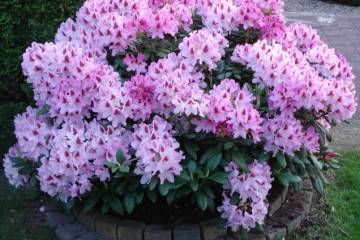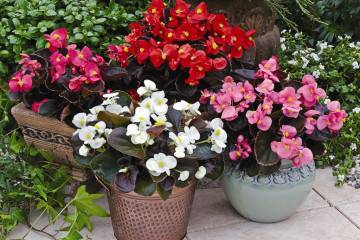Garden begonia in a flower bed - planting and care
Content:
Begonia is a flowering plant common in Russia. Novice flower growers may have a question: is begonia a houseplant or an outdoor plant? The correct answer is both: the plant is great for growing in the garden, in summer cottages and in pots on the street, and in addition, the flower is successfully bred indoors. In harsh climates in winter, the plant is always kept indoors.
Garden begonia: general information
Begonia (lat. Begonia) belongs to the large family of Begonia. The genus itself has more than 1,500 varieties and hybrid varieties, which speaks of the popularity of the flower and the interest of breeders in it.
Garden begonia is an ornamental flowering perennial of a shrub or semi-shrub form native to tropical humid regions and drier mountainous regions. Gardeners appreciate begonias for their long flowering time, which often lasts until November. Its types differ in the height of the bush, the shape and color of the flowers.
Popular garden varieties:
- Golden ball;
- Firemeer;
- Minion.
The color palette of buds is very rich: white, pink, red, crimson shades adorn flower beds and verandas. The flowering of begonia can be very dense - under favorable conditions, the flowers overlap all the greenery around.
Ornamental foliage types of begonias are also quite popular, especially variegated (variegated) varieties. However, gardeners prefer to grow flowering varieties in flower beds, the choice of which is great.
The roots of the garden begonia are tuberous or thickened tuberous. Breeding the plant is possible by dividing the tuber, cuttings, seeds and leaves. The height of adult bushes is usually 20-30 cm.
Street begonia: planting and care
The flower is successfully grown outdoors in the open field. Begonia is planted on the beds in the form of tubers, cuttings or young seedlings.
Planting tubers
The tuber should be young, up to 4-6 cm in diameter, with live buds - "eyes". Before planting, the shoots are examined, the dry roots are removed. You can carry out a small disinfection - soak the tuber in a low-concentration solution of hydrogen peroxide for about half an hour.
If mold is found on the planting material, it is carefully removed with a soft-bristled brush and soaked in a disinfecting solution.
Begonia tubers are planted in March-April in planting containers or in May-June directly in open ground. One tuber can produce several plants. Divided tuberous lobes or sprouts from a tuber are planted in small individual containers (cups) and sprinkled with soil on top. After rooting, which usually does not take long, the seedlings are transferred to open ground.
In winter, the tubers are stored in moist sand in a cool place, such as a cellar. If there is no such room, then a refrigerator shelf will do. From time to time, you need to add water to the sand, but do not pour the tuber, otherwise it will start to rot.
Begonia cuttings
With the cuttings method, the tops of healthy flowering plants are cut off.About three pairs of leaves should remain on the stem, the buds and inflorescences are removed. The lower sections are treated with a substance that stimulates root growth.
Rooting cuttings are placed in peat pots, which are then planted in open ground. Such containers are organic products, their walls are made of peat-wood mass with the addition of chalk (high moor peat, up to 70% in the composition). This is necessary to maintain the integrity of the root system. The soil mixture for pots is taken slightly acidic, with a high content of peat and nutrients. You can purchase ready-made soil for begonias.
In May, containers with cuttings are placed in the ground and covered with transparent plastic bags. The temperature outside should be at least 18-22 ° C.
When the plants get stronger, the bags are removed completely.
The interval between young plantings should be about 15-20 cm. It is recommended to plant begonias of different shades: this will create a variegated flowering carpet.
How to grow a bush from seeds
The procedure takes place in February. A container with soft peat soil is taken (a low box for seedlings), the seeds are laid out on the surface, they do not need to be deeply sunk. For better adhesion to the ground, it is enough to spray with a spray bottle. The container is covered with a transparent lid to create a greenhouse-like environment. Florists often use food plastic containers with a lid attached to the side for this purpose.
The seeds are checked and aired daily. When sprouts appear, they are no longer covered with a lid. Young begonias are planted in a flower bed when they reach a height of five to six centimeters. When transplanting, you need to pay attention to the roots: in healthy specimens, they will already be quite long and branched.
Outdoor care in a flower bed
Begonia in the garden requires attention and adherence to certain rules of care.
Seat selection
The place for the bushes is chosen sunny, but one where direct sunlight does not fall. Sometimes the plant drops buds if the place is open to the scorching sun. In this case, the bush will have to be moved along with the earthen lump to a shady place.
On the ground around the bushes, you can lay a layer of mulch from expanded clay, tree bark and chips. This frees the grower from the need to weed and loosen the flower beds, and helps maintain the required level of humidity.
Soil fertilization
Fertilizers for begonia are applied every two weeks. Phosphorus-potassium dressing is done from the moment of flowering. It is needed to stimulate the ovary, improve budding. The flowering density will be higher and the plant will look healthier. Products for flowering plants from Etisso (Germany) have proven themselves well.
Nitrogen fertilizers are intended for deciduous varieties as they help build green mass. It should be remembered that nitrogen slows down the formation of buds.
Watering
Originally from the tropics, begonia loves high humidity, so you need to water it regularly, every three days during the period of active growth. The water is taken soft, settled. Garden peat can be added to the water - about 1 kg per 10 liters of water. It is better to water the bushes in the morning. In summer, in the heat, you can water the flower beds every other day and make sure that no water lingers in the ground.
To prevent powdery mildew, which appears from an excess of moisture, it is recommended to spray the plants with a liquid agent for flower crops. If white spots are found on the leaves, it means that the disease has already hit the bush. A diseased plant will have to be removed so as not to infect neighboring specimens.With an excess of moisture, the bush sheds buds. This is a signal that watering should be reduced.
Pests
Most begonia suffer from aphids, scale insects, thrips, whiteflies, nematodes and spider mites. To get rid of them, the bushes are sprayed with a solution of laundry soap, followed by rinsing with clean water. For spraying, special garden chemicals are also used.
For treatment and prevention, sticks or tablets from insect pests help. The advantage of such sticks is that they have a double effect: they not only protect the plant, but at the same time act as a fertilizer. It can be a nitrogen-phosphorus-potassium fertilizer containing trace elements such as zinc, boron, iron. With each watering, the soil receives another portion of protection and fertilization.
Why begonia doesn't bloom
If ovaries do not form, you need to revise the main parameters of the external environment:
- lighting;
- air temperature;
- watering mode;
- humidity.
If the soil is poor in nutrients, you should select high-quality fertilizers for flowering plants and apply them, focusing on the manufacturer's instructions. The soil must be selected loose, with a high content of peat and sand. Sometimes only plant transplanting or complete soil replacement helps.
Preparing for winter
Around the middle of autumn, begonias are removed together with the tuber, the stems are cut, leaving only short ones, 2-3 cm tall. Tubers need to be cleaned of soil, rinsed and dried well. They can then be removed to a cool place and checked from time to time for mold growth.
Features of growing begonias in pots in the country
Begonia grows well both outdoors and indoors. It is convenient to grow begonias in pots on the street, because they can be moved around the site, brought into the house in case of bad weather. Some varieties bloom all year round, including at home, if the owner takes proper care of the plant and pruns it on time.
In late autumn, street pots are removed indoors, the upper part of the tuberous species is cut off, the tuber itself can not be removed. The pot is placed in a dark, cool place and left alone for the entire winter.
Street begonia is popular with flower growers for its high decorative characteristics. Growing begonias in the garden and caring for them is not difficult, however, this requires a certain skill. In gratitude, perennial garden begonia pleases the eye with long flowering.

